warning SSANGYONG NEW ACTYON SPORTS 2013 Repair Manual
[x] Cancel search | Manufacturer: SSANGYONG, Model Year: 2013, Model line: NEW ACTYON SPORTS, Model: SSANGYONG NEW ACTYON SPORTS 2013Pages: 751, PDF Size: 72.63 MB
Page 616 of 751
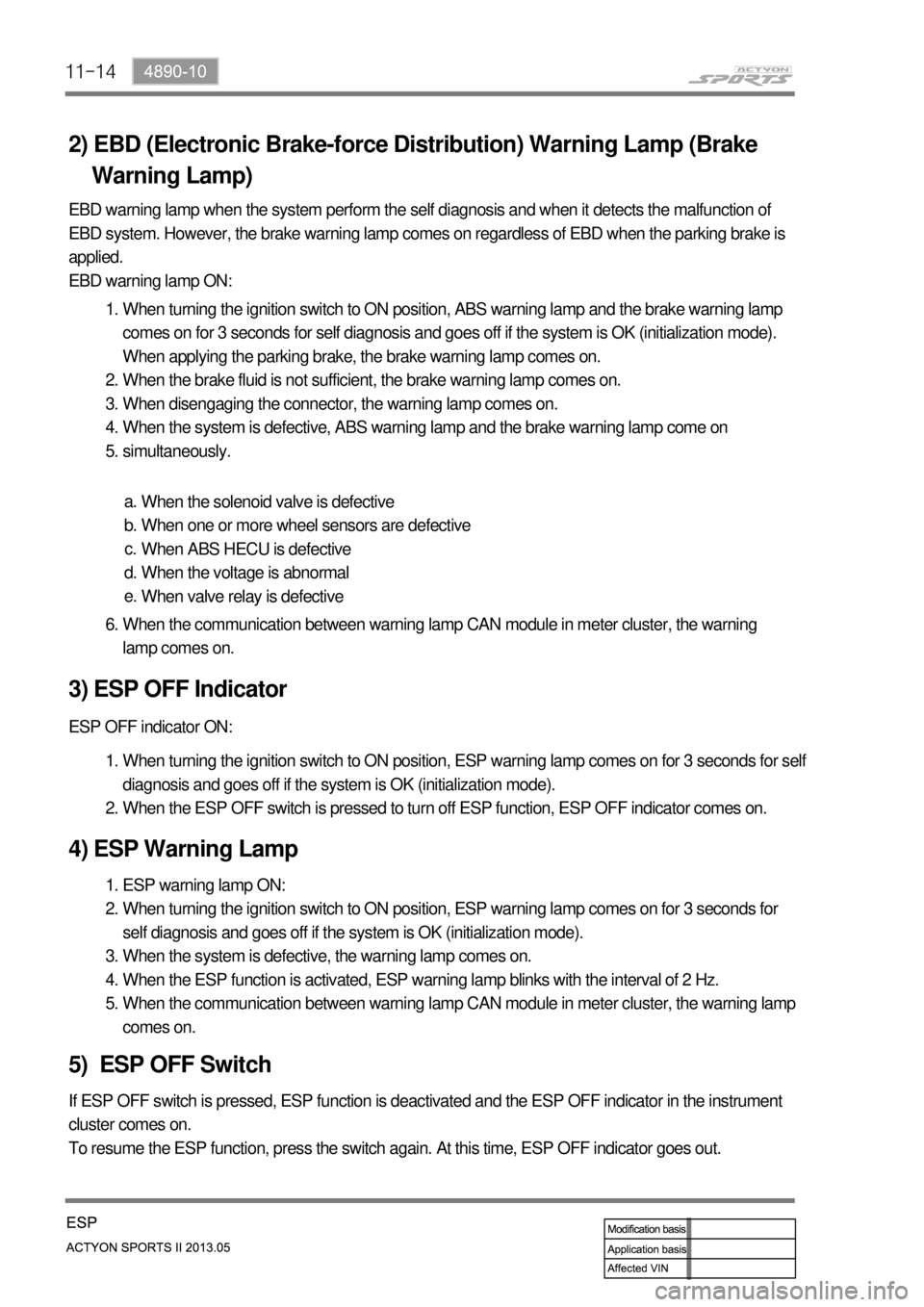
11-14
2) EBD (Electronic Brake-force Distribution) Warning Lamp (Brake
Warning Lamp)
EBD warning lamp when the system perform the self diagnosis and when it detects the malfunction of
EBD system. However, the brake warning lamp comes on regardless of EBD when the parking brake is
applied.
EBD warning lamp ON:
When turning the ignition switch to ON position, ABS warning lamp and the brake warning lamp
comes on for 3 seconds for self diagnosis and goes off if the system is OK (initialization mode).
When applying the parking brake, the brake warning lamp comes on.
When the brake fluid is not sufficient, the brake warning lamp comes on.
When disengaging the connector, the warning lamp comes on.
When the system is defective, ABS warning lamp and the brake warning lamp come on
simultaneously. 1.
2.
3.
4.
5.
When the solenoid valve is defective
When one or more wheel sensors are defective
When ABS HECU is defective
When the voltage is abnormal
When valve relay is defective a.
b.
c.
d.
e.
When the communication between warning lamp CAN module in meter cluster, the warning
lamp comes on. 6.
3) ESP OFF Indicator
ESP OFF indicator ON:
When turning the ignition switch to ON position, ESP warning lamp comes on for 3 seconds for self
diagnosis and goes off if the system is OK (initialization mode).
When the ESP OFF switch is pressed to turn off ESP function, ESP OFF indicator comes on. 1.
2.
4) ESP Warning Lamp
ESP warning lamp ON:
When turning the ignition switch to ON position, ESP warning lamp comes on for 3 seconds for
self diagnosis and goes off if the system is OK (initialization mode).
When the system is defective, the warning lamp comes on.
When the ESP function is activated, ESP warning lamp blinks with the interval of 2 Hz.
When the communication between warning lamp CAN module in meter cluster, the warning lamp
comes on. 1.
2.
3.
4.
5.
5) ESP OFF Switch
If ESP OFF switch is pressed, ESP function is deactivated and the ESP OFF indicator in the instrument
cluster comes on.
To resume the ESP function, press the switch again. At this time, ESP OFF indicator goes out.
Page 624 of 751
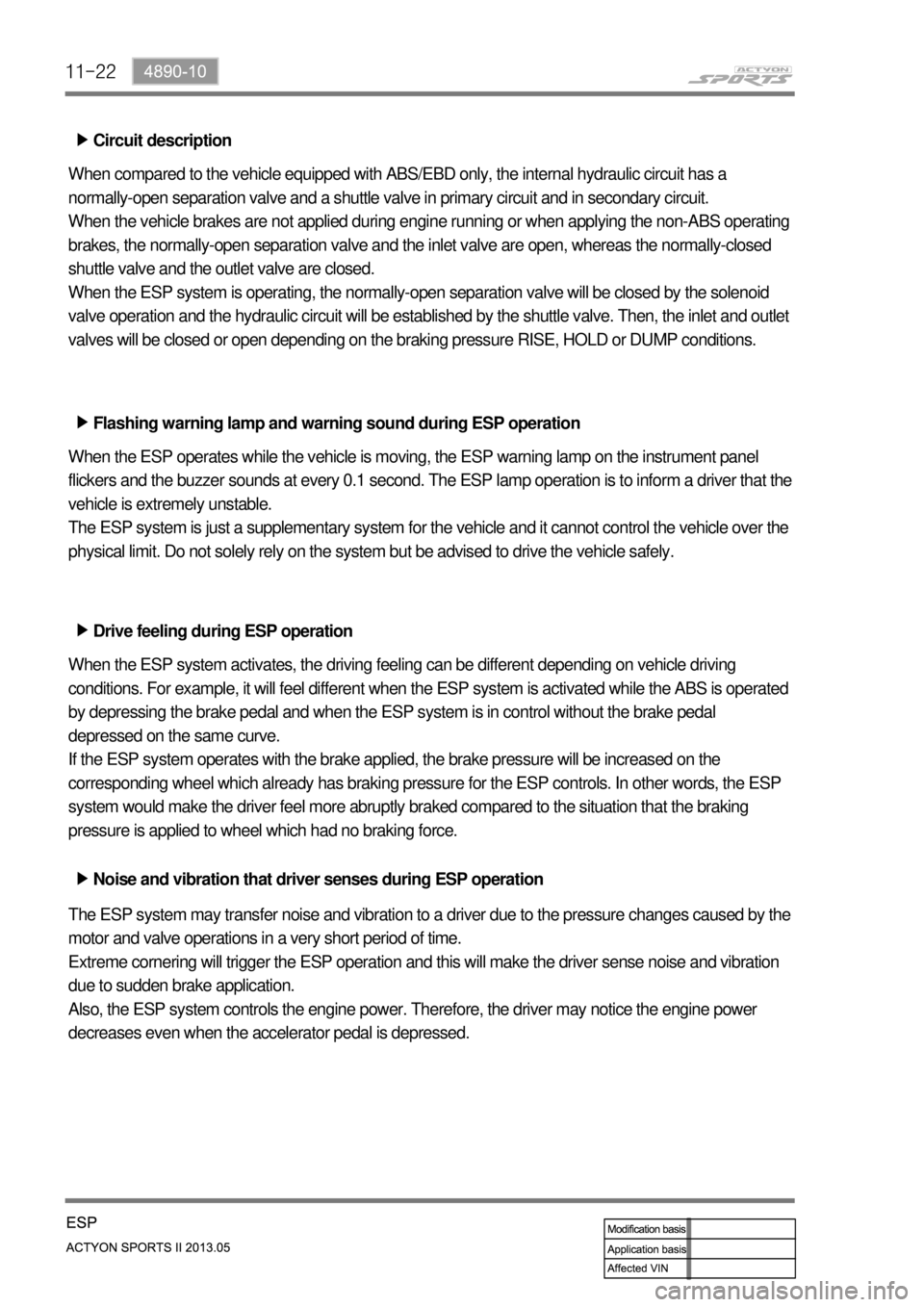
11-22
Circuit description ▶
When compared to the vehicle equipped with ABS/EBD only, the internal hydraulic circuit has a
normally-open separation valve and a shuttle valve in primary circuit and in secondary circuit.
When the vehicle brakes are not applied during engine running or when applying the non-ABS operating
brakes, the normally-open separation valve and the inlet valve are open, whereas the normally-closed
shuttle valve and the outlet valve are closed.
When the ESP system is operating, the normally-open separation valve will be closed by the solenoid
valve operation and the hydraulic circuit will be established by the shuttle valve. Then, the inlet and outlet
valves will be closed or open depending on the braking pressure RISE, HOLD or DUMP conditions.
Flashing warning lamp and warning sound during ESP operation ▶
When the ESP operates while the vehicle is moving, the ESP warning lamp on the instrument panel
flickers and the buzzer sounds at every 0.1 second. The ESP lamp operation is to inform a driver that the
vehicle is extremely unstable.
The ESP system is just a supplementary system for the vehicle and it cannot control the vehicle over the
physical limit. Do not solely rely on the system but be advised to drive the vehicle safely.
Drive feeling during ESP operation ▶
When the ESP system activates, the driving feeling can be different depending on vehicle driving
conditions. For example, it will feel different when the ESP system is activated while the ABS is operated
by depressing the brake pedal and when the ESP system is in control without the brake pedal
depressed on the same curve.
If the ESP system operates with the brake applied, the brake pressure will be increased on the
corresponding wheel which already has braking pressure for the ESP controls. In other words, the ESP
system would make the driver feel more abruptly braked compared to the situation that the braking
pressure is applied to wheel which had no braking force.
Noise and vibration that driver senses during ESP operation ▶
The ESP system may transfer noise and vibration to a driver due to the pressure changes caused by the
motor and valve operations in a very short period of time.
Extreme cornering will trigger the ESP operation and this will make the driver sense noise and vibration
due to sudden brake application.
Also, the ESP system controls the engine power. Therefore, the driver may notice the engine power
decreases even when the accelerator pedal is depressed.
Page 634 of 751

12-54610-01
SSPS warning lamp
Comes on when SSPS system has a fault
Power steering supply hose and return hose for
SSPS model
Power steering pump with SSPS
Installed view Pump components
Page 657 of 751

13-74620-01
SSPS warning lamp
Comes on when SSPS system has a fault
Power steering supply hose and return hose for
SSPS model
Power steering pump with SSPS
Installed view Pump components
Page 658 of 751

13-8
3. HOW TO OPERATE
1) Input/Output of SSPS Control Unit
Meter Cluster
(Vehicle Speed)SSPS
Control
Unit
Solenoid Valve
Meter cluster
(SSPS warning lamp)
Trouble Diagnosis
2) SSPS Configuration
Ground IG Power
Page 713 of 751

02-4
2. OPERATING RANGE
In the event of the collision, the air bag will be deployed when the G value detected by the G
sensor in the SDM is beyond the impact limit. ▶
Seat Belt Status Air Bag OperationSeat Belt Pretensioner Operation
Fastened Over reference speed Below reference speed
Unfastened Below reference speed Inoperative
Failure, during initial
diagnosisBelow reference speed Below reference speed
No sensor Below reference speed Below reference speed
This is based on frontal collision and reference speed is between approx. 4 and 24 km/h. *
The air bag is deployed in the event of frontal collisions while drving.
But, there are exceptional cases as follows: ▶
Situation Condition
May operate or not
Never operate
Seldom oeprate
Underbody impact from the road surface, impact against the curb at a
very high speed, or dropping impact onto the road surface with a
large angle occurs.
The vehicle rolls over or tips over sideward by severe impact. -
-
A collision with oblique impact to the front seat direction or a front collision
to the diagonal direction occurs.
A front/rear collision occurs.
The vehicle rolls over or tips over sideward with minor impact.
The air bag warning lamp is on. -
-
-
-The vehicle is stationary or a front collision occurs with low speed.
A rear collision occurs.
A minor collision occurs. -
-
-
Page 714 of 751
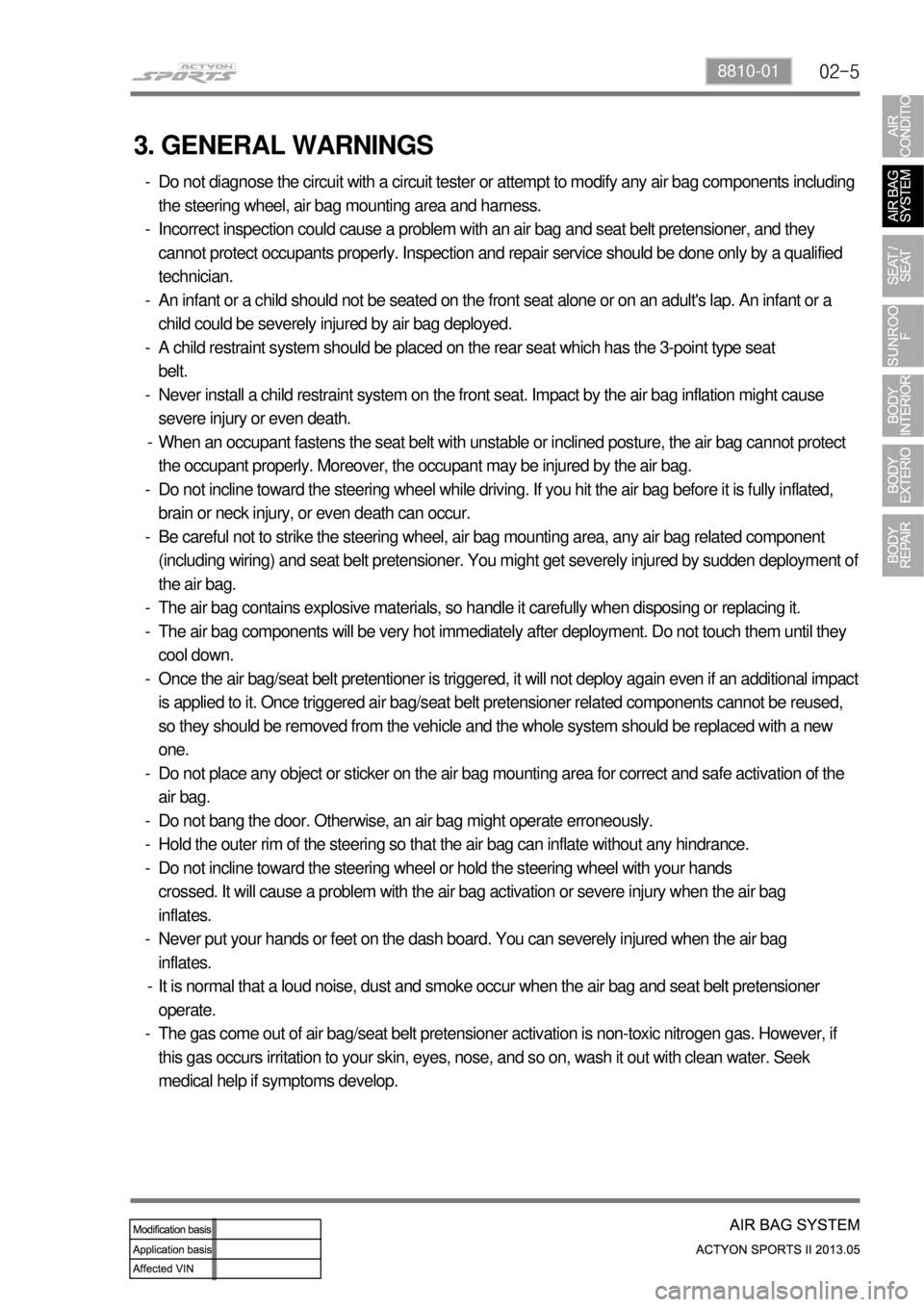
02-58810-01
3. GENERAL WARNINGS
Do not diagnose the circuit with a circuit tester or attempt to modify any air bag components including
the steering wheel, air bag mounting area and harness.
Incorrect inspection could cause a problem with an air bag and seat belt pretensioner, and they
cannot protect occupants properly. Inspection and repair service should be done only by a qualified
technician.
An infant or a child should not be seated on the front seat alone or on an adult's lap. An infant or a
child could be severely injured by air bag deployed.
A child restraint system should be placed on the rear seat which has the 3-point type seat
belt.
Never install a child restraint system on the front seat. Impact by the air bag inflation might cause
severe injury or even death.
When an occupant fastens the seat belt with unstable or inclined posture, the air bag cannot protect
the occupant properly. Moreover, the occupant may be injured by the air bag.
Do not incline toward the steering wheel while driving. If you hit the air bag before it is fully inflated,
brain or neck injury, or even death can occur.
Be careful not to strike the steering wheel, air bag mounting area, any air bag related component
(including wiring) and seat belt pretensioner. You might get severely injured by sudden deployment o
f
the air bag.
The air bag contains explosive materials, so handle it carefully when disposing or replacing it.
The air bag components will be very hot immediately after deployment. Do not touch them until they
cool down.
Once the air bag/seat belt pretentioner is triggered, it will not deploy again even if an additional impac
t
is applied to it. Once triggered air bag/seat belt pretensioner related components cannot be reused,
so they should be removed from the vehicle and the whole system should be replaced with a new
one.
Do not place any object or sticker on the air bag mounting area for correct and safe activation of the
air bag.
Do not bang the door. Otherwise, an air bag might operate erroneously.
Hold the outer rim of the steering so that the air bag can inflate without any hindrance.
Do not incline toward the steering wheel or hold the steering wheel with your hands
crossed. It will cause a problem with the air bag activation or severe injury when the air bag
inflates.
Never put your hands or feet on the dash board. You can severely injured when the air bag
inflates.
It is normal that a loud noise, dust and smoke occur when the air bag and seat belt pretensioner
operate.
The gas come out of air bag/seat belt pretensioner activation is non-toxic nitrogen gas. However, if
this gas occurs irritation to your skin, eyes, nose, and so on, wash it out with clean water. Seek
medical help if symptoms develop. -
-
-
-
-
-
-
-
-
-
-
-
-
-
-
-
-
-
Page 719 of 751

02-10
STICS
40 ms after receiving the air bag deployment signal at
the vehicle speed 3 km/h or higher, it sends out the door
UNLOCK signal for 5 seconds.Driver side (pretensioner)
Air Bag Warning Lamp
2. CONFIGURATION
Seat belt pretensioner
Driver Air Bag
(DAB)
Page 725 of 751
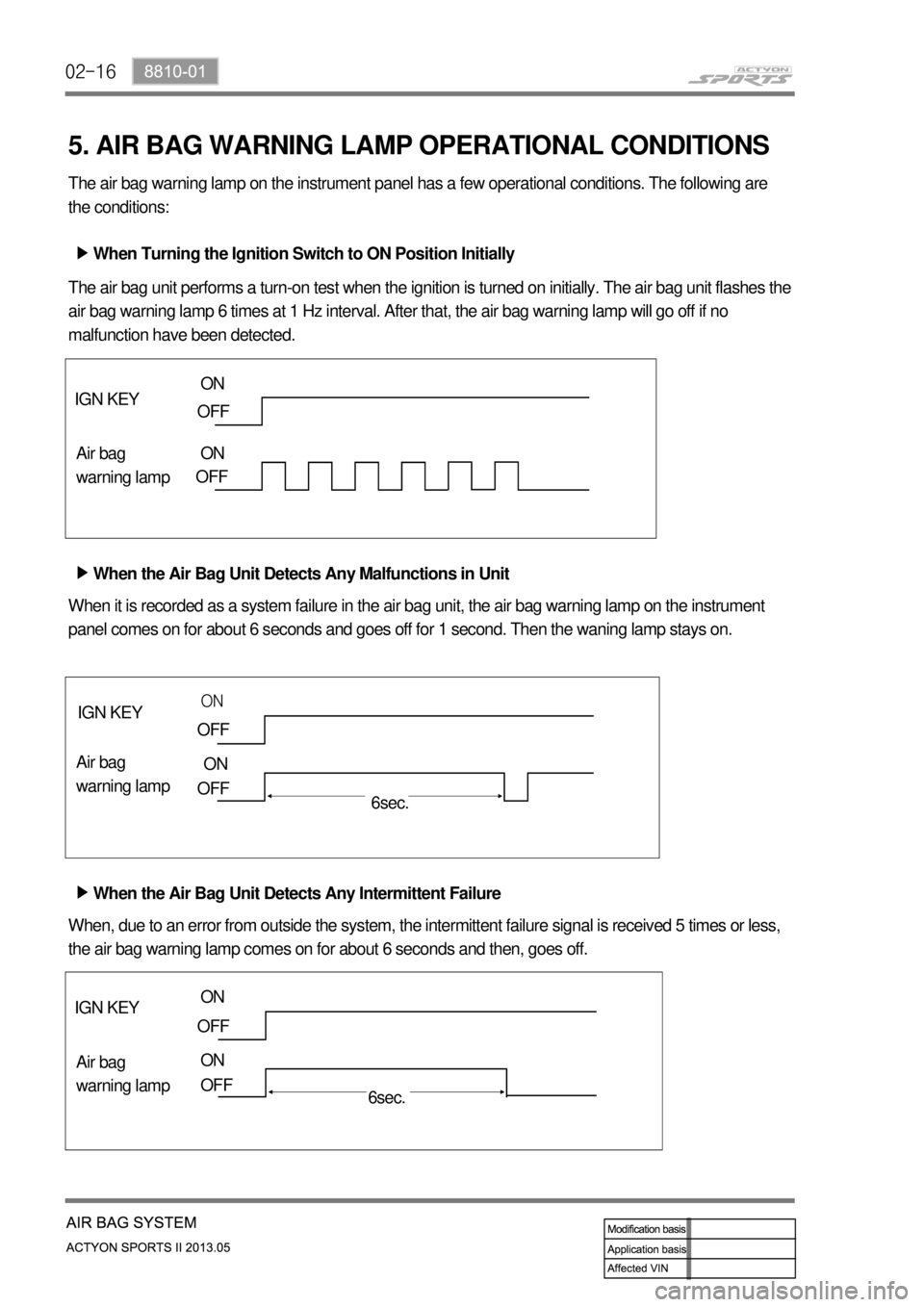
02-16
5. AIR BAG WARNING LAMP OPERATIONAL CONDITIONS
The air bag warning lamp on the instrument panel has a few operational conditions. The following are
the conditions:
When Turning the Ignition Switch to ON Position Initially ▶
The air bag unit performs a turn-on test when the ignition is turned on initially. The air bag unit flashes the
air bag warning lamp 6 times at 1 Hz interval. After that, the air bag warning lamp will go off if no
malfunction have been detected.
When the Air Bag Unit Detects Any Malfunctions in Unit ▶
When the Air Bag Unit Detects Any Intermittent Failure ▶ When it is recorded as a system failure in the air bag unit, the air bag warning lamp on the instrument
panel comes on for about 6 seconds and goes off for 1 second. Then the waning lamp stays on.
When, due to an error from outside the system, the intermittent failure signal is received 5 times or less,
the air bag warning lamp comes on for about 6 seconds and then, goes off.
IGN KEY
Air bag
warning lamp
IGN KEY
Air bag
warning lamp IGN KEY
Air bag
warning lamp
ON
OFF
OFF ON
OFF
ON
OFF
ON
OFF
ON
OFF
6sec.
6sec. ON
Page 728 of 751
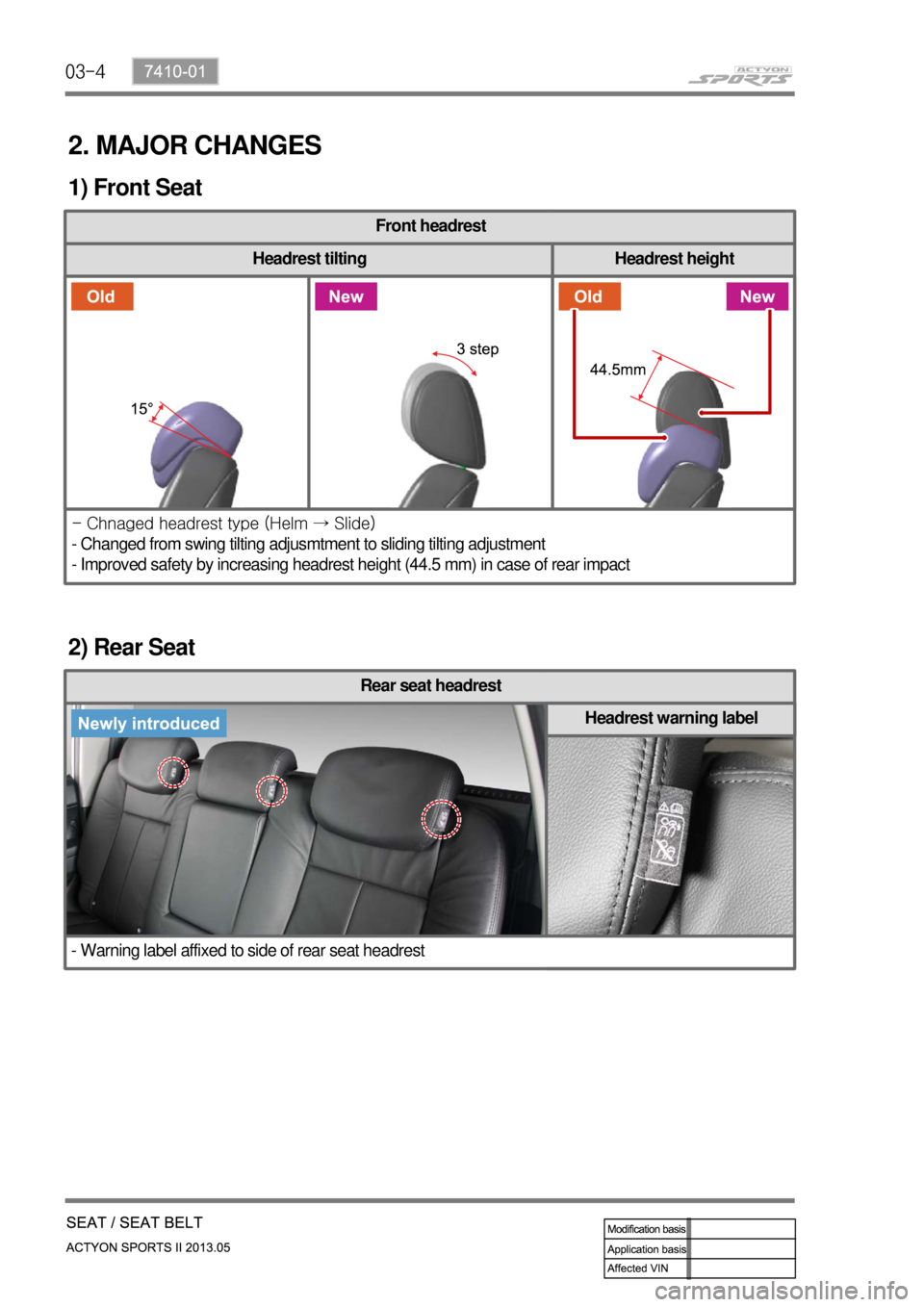
03-4
2. MAJOR CHANGES
1) Front Seat
Front headrest
Headrest tilting Headrest height
- Chnaged headrest type (Helm → Slide)
- Changed from swing tilting adjusmtment to sliding tilting adjustment
- Improved safety by increasing headrest height (44.5 mm) in case of rear impact
2) Rear Seat
Rear seat headrest
- Warning label affixed to side of rear seat headrest
Headrest warning label